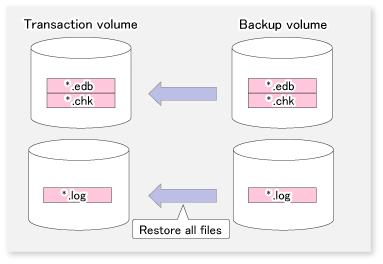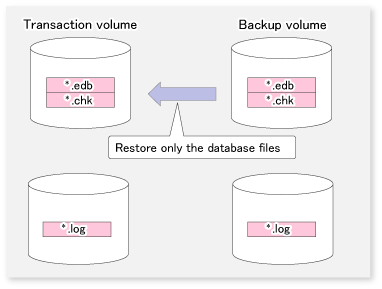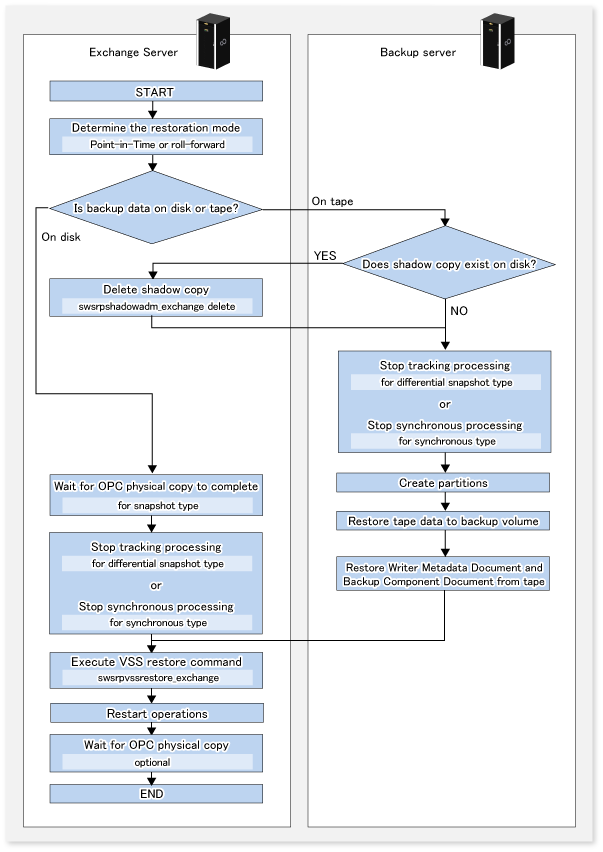The following steps must be completed before performing a restoration:
Confirm an environmental setting is done by the same composition as the backup referring to "8.2.3 Preparation".
Use the Exchange Management Console and set the "Overwrite this database when restoring" option for database to be restored.
Use the Exchange Management Console and dismount database to be restored. After dismounting the stores, close the Exchange Management Console.
When the Exchange Server 2007 is running on WSFC, the transaction volume that is the restoration destination is a WSFC shared volume. Therefore, resource monitoring for the target physical disk must be stopped before a restoration is executed. If restoration is executed without stopping resource monitoring, failover will happen for the cluster group.
Note
The disks for which resource monitoring is to be stopped differ according to the restoration method. Refer to "8.1.5.2 Executing the restoration" for more information.
For "Point-in-Time" restorations, all physical disk resources where storage groups or databases (files with extensions *.edb, *.log and *.chk) are located must be stopped.
For roll-forward restorations, only physical disk resources where database files (files with extension *.edb) are located must be stopped. In this case, no problems will occur if resource monitoring is stopped for all physical disk resources where the Log file or CHK file is located.
Stop resource monitoring by switching the resources to maintenance mode by using the cluster command.
[Example (Switching physical disk resource "Disk J:" to maintenance mode)]
C:\>cluster ExampleCluster res "Disk J:" /maint:on Setting maintenance mode for resource 'Disk J:' Resource Group Node Status -------------------- -------------------- --------------- ------ Disk J: GRP1 NODE1 Online(Maintenance) C:\> |
For differential snapshot type backups, all of the QuickOPCs that have been set up on the transaction disk must be cancelled using swsrpshadowadm_exchange (Exchange VSS shadow copy management command) before the restoration is executed. swsrpshadowadm_exchange (Exchange VSS shadow copy management command) can be used to check the QuickOPC sessions that have been set up on the transaction disk.
Note
Restoration cannot be executed if there are any backup disks on the transaction disk that are undergoing QuickOPC.
In order to cancel QuickOPC where physical copies are in progress, the shadow copies must be deleted first.
For Exchange Server 2013, stop the Microsoft Exchange Search Host Controller service on the restore destination server. However, stopping the Microsoft Exchange Search Host Controller service may affect the creation or search of index.
In consideration of the impact of stopping this service, recommend to take the action.
Restoration is performed separately for each storage group (for Exchange Server 2007) or for each database (for Exchange Server 2010 or Exchange Server 2013), using swsrpvssrestore_exchange (Exchange VSS restore execution command) on the Exchange server. When this command is executed, all of the databases (i.e. stores) to be restored must be dismounted. Restoration is performed using AdvancedCopy (OPC).
There are two restoration methods:
Point-in-time restoration (restoring to the point when the (last) backup was taken)
Roll-forward restoration (restoring to the latest point)
Point-in-time restoration works by restoring databases to the state they were in when the backup was taken. Point-in-time restorations are executed by specifying the -point option with swsrpvssrestore_exchange (Exchange VSS restore execution command). If the -point option is specified, this command will restore the database to the point when the backup was taken by restoring all of the backup files (files with extensions *.edb, *.log and *.chk).
Figure 8.50 Point-in-time restoration

Example:
For Exchange Server 2007
C:\>set SWSTGNODE=nodeAGT C:\>C:\Win32App\AdvancedCopyManager\bin\swsrpvssrestore_exchange -evs VSVR -point -sgname FirstStorageGroup swsrpvssrestore_exchange successfully completed C:\> |
For Exchange Server 2010 or Exchange Server 2013
C:\>C:\Win32App\AdvancedCopyManager\bin\swsrpvssrestore_exchange -point -dbname Mailbox1 swsrpvssrestore_exchange successfully completed C:\> |
Roll forward restorations restore databases to the latest point.
Roll forward restorations are executed by specifying the -roll option with swsrpvssrestore_exchange (Exchange VSS restore execution command). If the -roll option is specified, the restore is performed as follows:
Only database files (with extension *.edb) are restored.
Logs are applied using the log files that exist on the transaction volume.
Databases are restored to the latest point.
Figure 8.51 Roll forward restoration

Example:
For Exchange Server 2007
C:\>set SWSTGNODE=nodeAGT C:\>C:\Win32App\AdvancedCopyManager\bin\swsrpvssrestore_exchange -evs VSVR -roll -sgname FirstStorageGroup swsrpvssrestore_exchange successfully completed C:\> |
For Exchange Server 2010 or Exchange Server 2013
C:\>C:\Win32App\AdvancedCopyManager\bin\swsrpvssrestore_exchange -roll -dbname Mailbox1 swsrpvssrestore_exchange successfully completed C:\> |
Note
In order to execute a roll forward restoration, the following conditions must be met:
All of the transaction logs that have been created since the latest complete backup was taken must exist.
The generation numbers (the "XXXXXXXX" part of EnnXXXXXXXX.log) of the existing log files must be consecutive.
A new backup must be created immediately if the database path is changed.
A new backup must be created immediately after the commands ESEUTIL /p (restores faults or damaged databases) or ESEUTIL /d (defrags or compresses databases) are executed.
A backup of all databases in the storage group must be taken immediately after any databases are added or deleted. (Only for Exchange Server 2007)
swsrpstat_exchange (Exchange operation status display command) can be used to check the restoration copy implementation status.
[Execution example (when OPC used to perform restoration)]
For Exchange Server 2007
C:\> C:\Win32App\AdvancedCopyManager\bin\swsrpstat_exchange -sgname FirstStorageGroup Server Original-Volume Replica-Volume Direction Status Execute EXCHG-SVR g1d1p1@EXCHG-SVR g1d11p1@BKUP-SVR reverse snap 80% EXCHG-SVR g1d2p1@EXCHG-SVR g1d12p1@BKUP-SVR reverse snap 63% EXCHG-SVR g1d1p1@EXCHG-SVR g1d13p1@BKUP-SVR ---- ---- ---- EXCHG-SVR g1d2p1@EXCHG-SVR g1d14p1@BKUP-SVR ---- ---- ---- C:\> |
For Exchange Server 2010 or Exchange Server 2013
C:\> C:\Win32App\AdvancedCopyManager\bin\swsrpstat_exchange -dbname Mailbox1 Server Original-Volume Replica-Volume Direction Status Execute EXCHG-SVR g1d1p1@EXCHG-SVR g1d11p1@BKUP-SVR reverse snap 80% EXCHG-SVR g1d2p1@EXCHG-SVR g1d12p1@BKUP-SVR reverse snap 63% EXCHG-SVR g1d1p1@EXCHG-SVR g1d13p1@BKUP-SVR ---- ---- ---- EXCHG-SVR g1d2p1@EXCHG-SVR g1d14p1@BKUP-SVR ---- ---- ---- C:\> |
The following steps must be completed after performing a restoration:
Start the Microsoft Exchange Search Host Controller service (only for Exchange Server 2013)
Restart resource monitoring for physical disks (only when Exchange Server 2007 and WSFC is operating)
Mounting the database
For the Exchange Server 2013, start the Microsoft Exchange Search Host Controller service on the restore destination server.
When the Exchange Server 2007 is running on WSFC, restart resource monitoring by cancelling maintenance mode for the physical disks where resource monitoring has been stopped.
[Example (Releasing physical disk resource "Disk J:" from maintenance mode)]
C:\>cluster ExampleCluster res "Disk J:" /maint:off Clearing maintenance mode for resource 'Disk J:' Resource Group Node Status -------------------- -------------------- --------------- ------ Disk J: GRP1 NODE1 Online C:\> |
For point-in-time restore, use the Exchange Management Console to mount stores that have been dismounted. Use the following procedure to mount the stores for roll forward restorations:
For roll forward restorations, either delete or rename the CHK file (EXX.chk). (For Point-in-Time restorations, do not perform this procedure.)
Use the Exchange Management Console to mount stores that have been dismounted.
When data backed up to tape is to be restored, the backup data on the tape first needs to be restored on the backup server and then the Exchange VSS restore command needs to be entered.
If the backup volume is used as a shadow copy, the backup data on the tape must be restored after deleting the shadow copy. The figure below shows the flow of a restoration from tape.
Figure 8.52 Snapshot restoration (restoration performed using OPC)
